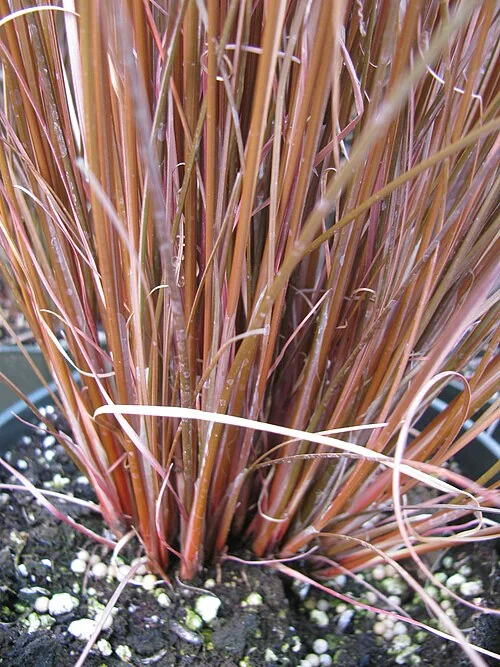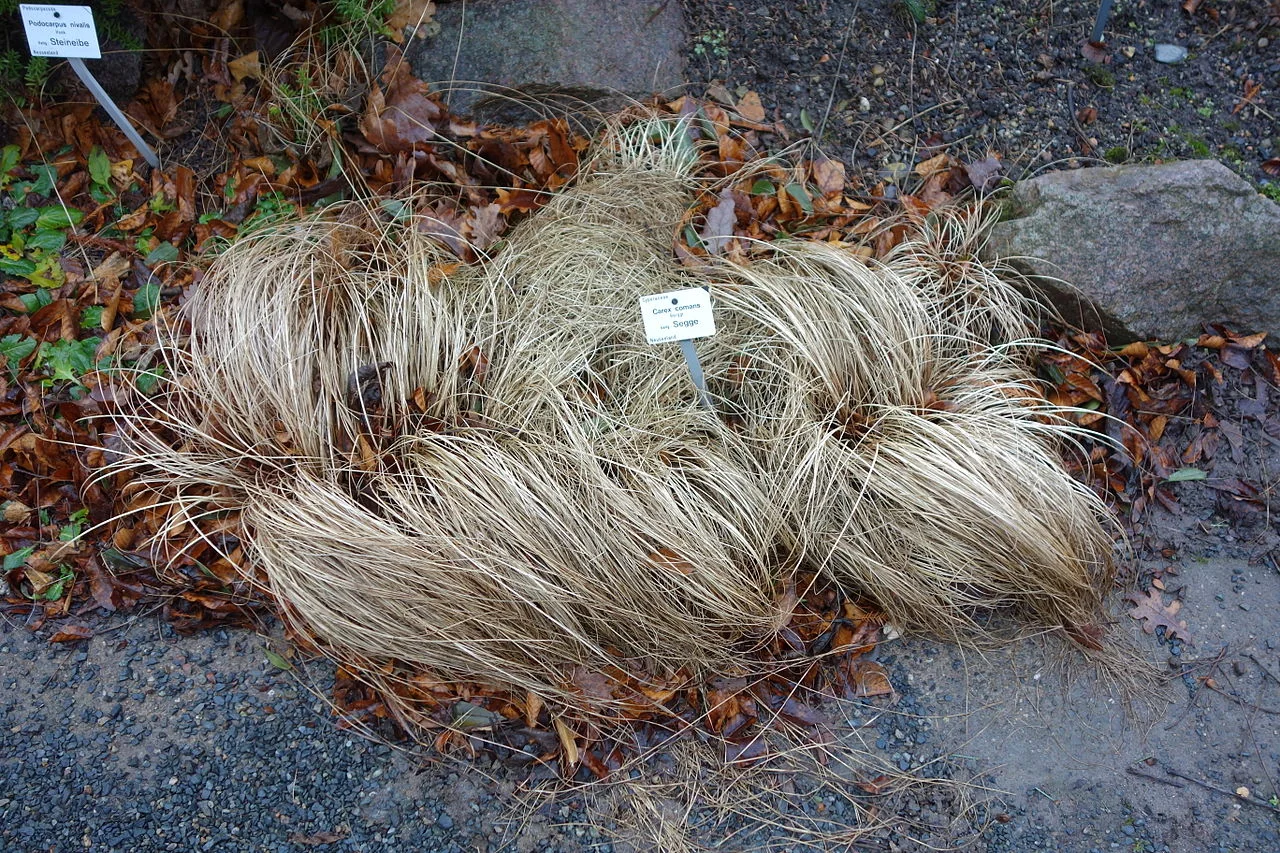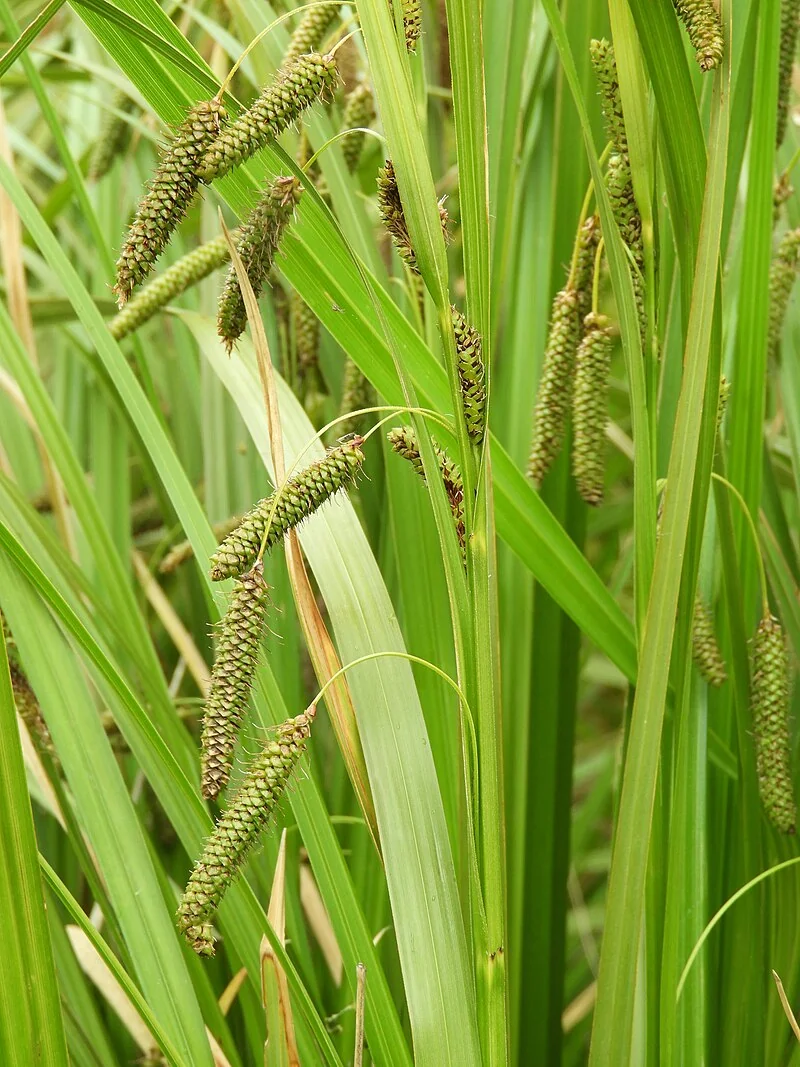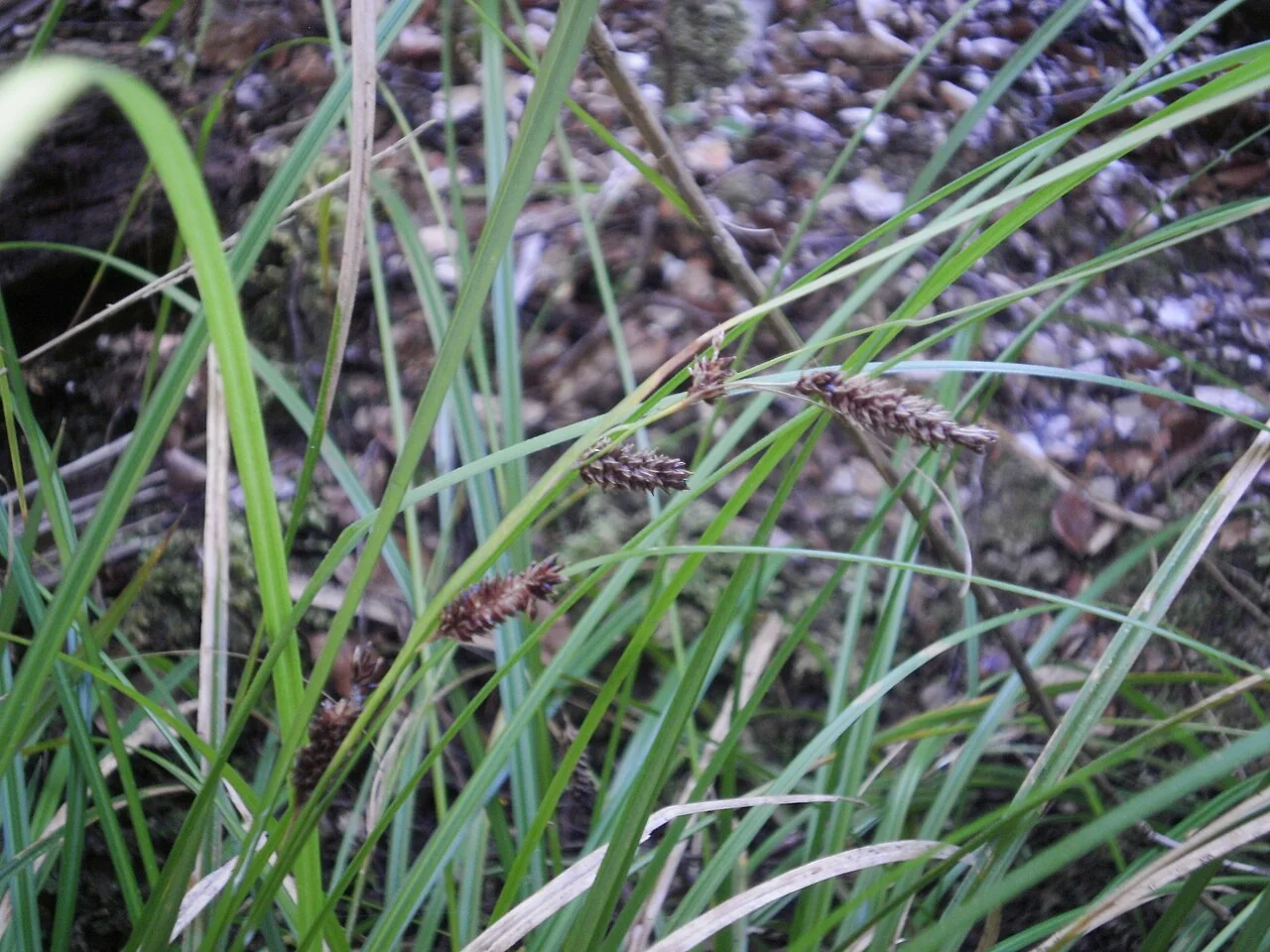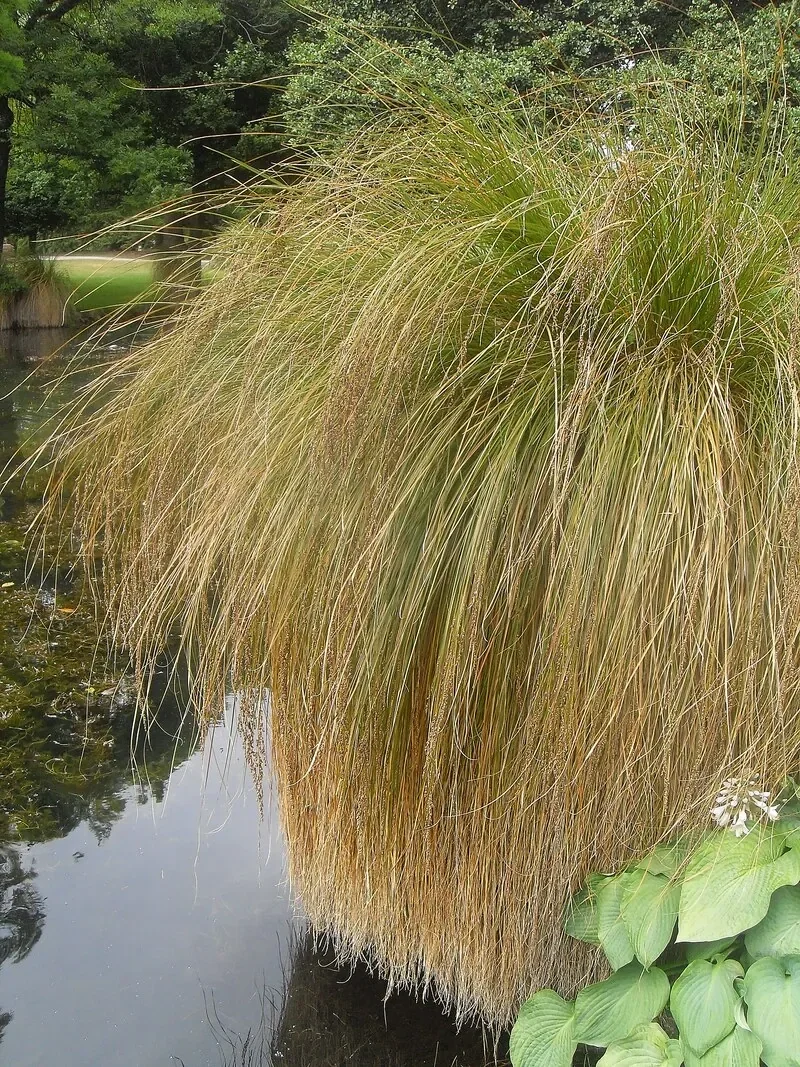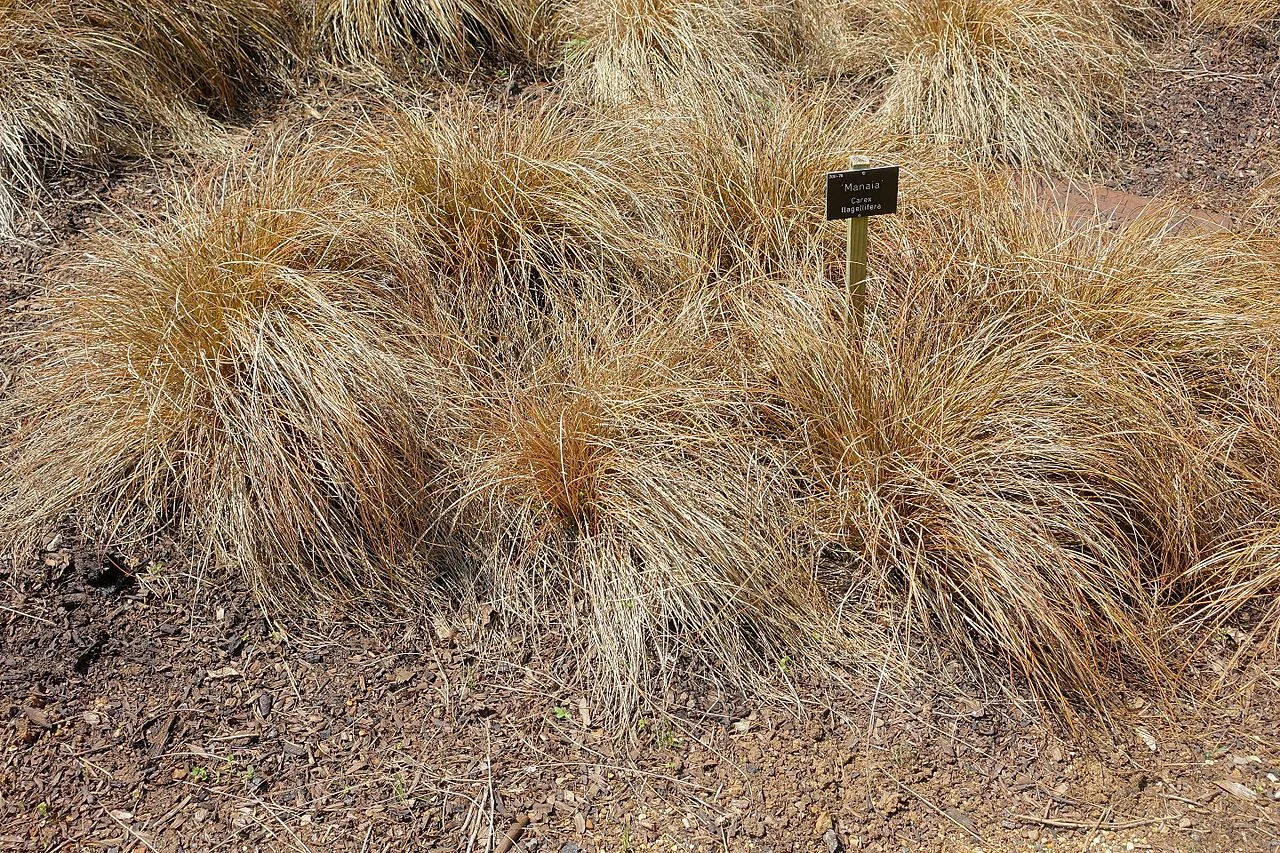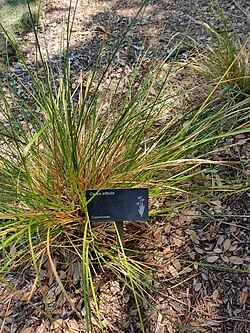
White Sedge
Carex albula
Explore more NZ native plant guides in our index .
Introduction
About White Sedge
Carex albula , commonly known as White Sedge or New Zealand Hair Sedge, is a distinctive and critically important native sedge endemic to a narrow band of the South Island's dry interior regions, specifically the Mackenzie Basin, Waitaki, and Central Otago. This remarkable species forms dense, stiffly erect to drooping clumps reaching 25-35cm tall, distinguished by its characteristic bleached white to buff-coloured foliage that creates an almost ghostly appearance in the landscape. As a Nationally Critical species, this local regional endemic faces significant conservation challenges from habitat modification, agricultural development, and competition from invasive species, making its cultivation and protection vital for maintaining New Zealand's unique botanical heritage in the face of ongoing environmental pressures.

Plant Description
Carex albula , commonly known as White Sedge or New Zealand Hair Sedge, is a distinctive perennial sedge endemic to the South Island of New Zealand. It forms dense, tufted clumps of fine, arching leaves that can range in colour from pale green to silvery-white, buff-coloured, or even green or red, often appearing softly bleached. This evergreen sedge typically grows 25-35 cm tall and is valued for its graceful, flowing texture. It produces small, inconspicuous cream spikes from October to December. Adapted to the harsh, continental climate of New Zealand's dry interior regions, it thrives in well-drained soils and can tolerate dry periods once established.
Quick Facts
Sedge Summary
| Scientific Name | Carex Albula |
|---|---|
| Height | 30-60 cm |
| Spread | 30-60 cm |
| Water Needs | Moderate; prefers consistently moist soil |
| Light | Full sun to partial shade |
| Frost Tolerance | High |
| Salt Tolerance | Low |
| Growth Rate | Moderate |
| Lifespan | Perennial |
Climate Best Suited to
Carex albula is specifically adapted to the harsh, continental climate conditions of New Zealand's dry interior regions, particularly the rain-shadow areas of the Mackenzie Basin, Waitaki, and Central Otago. This critically threatened endemic species inhabits alluvial terraces, colluvial slopes, and river flats where it has evolved to tolerate extreme temperature fluctuations, drought conditions, and intense UV exposure typical of high-country continental climates. Its restricted distribution reflects its specialized adaptation to these challenging environments where hot, dry summers and cold winters create conditions unsuitable for most other sedge species.
Regional Suitability
| Whangārei | Ideal |
| Auckland | Ideal |
| Hamilton | Suitable |
| Rotorua | Suitable |
| Tauranga | Ideal |
| Gisborne | Ideal |
| New Plymouth | Ideal |
| Whanganui | Ideal |
| Palmerston North | Suitable |
| Napier | Ideal |
| Wellington | Ideal |
| Nelson | Ideal |
| Christchurch | Suitable |
| Dunedin | Suitable |
| Invercargill | Suitable |
| City | Climate Suitability |
|---|
Habitat
Natural Distribution
Carex albula , commonly known as White Sedge or New Zealand Hair Sedge, is a native sedge endemic to the South Island of New Zealand. It is typically found on alluvial terraces, colluvial slopes, and river flats within the dry interior regions, specifically the Mackenzie Basin, Waitaki, and Central Otago.
This plant prefers free-draining soils and is often a component of grey scrub communities. While it can tolerate wet sites, it does not withstand submersion, and its crown should remain above water. Its habitat is characterized by harsh, continental climate conditions with extreme temperature fluctuations, drought conditions, and intense UV exposure. It is also noted to persist in paddocks alongside cattle and sheep, suggesting it is unpalatable to them, which contributes to its survival in modified landscapes.
Plant Conservation
Carex albula is classified as "Threatened - Nationally Critical" as of 2023, representing the most urgent conservation status in New Zealand's threat classification system. This represents a significant escalation from its previous classification as "Nationally Vulnerable" in 2017, indicating severe population decline or newly recognized threats.
As a local regional endemic to the South Island's dry interior regions including the Mackenzie Basin, Waitaki, and Central Otago, this distinctive white sedge has an extremely restricted natural distribution. The species faces multiple conservation challenges including habitat modification from agricultural development, competition from invasive plants, and loss of suitable habitat through land use changes.
Key threats include agricultural impacts where plants have been lost to spraying and cultivation activities, despite the species appearing unpalatable to livestock. The sedge's inability to tolerate competition from taller species makes it vulnerable to habitat changes that favour more aggressive plant communities. Its specific habitat requirements for free-draining soils on alluvial terraces and river flats make it particularly susceptible to hydrological changes and land development.
Conservation efforts focus on habitat protection, population monitoring, and ex-situ cultivation to preserve genetic diversity. The species' popularity in horticulture provides opportunities for conservation through cultivation, helping maintain viable populations while raising public awareness of New Zealand's critically threatened flora. Immediate priority is given to protecting remaining wild populations and their specialized dry interior habitats.
Growing Requirements
Soil Requirements
Prefers moist, well-drained, fertile soil with good organic content.
Light Requirements
Grows best in full sun to partial shade.
Water Requirements
Requires consistent moisture, especially during dry periods. Do not allow the soil to dry out completely.
Planting Guide
-
When to Plant
Plant in autumn or spring.
-
Site Preparation
Choose a sunny or partially shaded site with moist, well-drained soil.
-
Planting and Aftercare
Dig a hole twice the width of the pot. Place the plant in the hole and backfill with soil. Water well and apply a layer of mulch.
Ecological Significance
Carex albula , commonly known as White Sedge or New Zealand Hair Sedge, is a species of sedge endemic to the South Island of New Zealand. Its ecological significance is multifaceted, particularly given its conservation status and role within its specialized habitats.
- Habitat and Food Source: Carex albula provides habitat and serves as a food source for various wildlife, including supporting the larvae of Satyr butterflies. This highlights its role in the local food web and its contribution to insect biodiversity.
- Soil Stabilization and Erosion Control: Its dense root systems contribute to soil stabilization and help prevent erosion, particularly in its preferred habitats of alluvial terraces, colluvial slopes, and river flats. This is crucial in maintaining the integrity of these often-disturbed landscapes.
- Nutrient Cycling: Like other Carex species, it plays a role in nutrient cycling within its environment, contributing to the overall health and fertility of the soil.
- Indicator Species: Carex albula can serve as an indicator of specific environmental conditions, particularly the health of grey scrub communities and alluvial terrace ecosystems.
- Persistence in Grazed Areas: It is seemingly unpalatable to livestock such as cattle and sheep, allowing it to persist in pastures where other plants might be heavily grazed. This unique trait contributes to its survival in modified landscapes.
- Conservation Status: While the IUCN Redlist declared its conservation status as "least concern" (LC), assessments under the New Zealand Threat Classification System (NZTCS) have listed it as "At Risk - Declining" in 2013 and "Threatened - Nationally Vulnerable" (NV) in 2017. This highlights its precarious status within its native range and the urgent need for conservation efforts to protect this endemic species from threats such as habitat modification and competition from invasive species.
Uses and Significance
Conservation Value
- Critical role in preserving New Zealand's endemic sedge diversity as a Nationally Critical species
- Essential component of threatened grey scrub communities in Central Otago ecosystems
- Specialized genetic adaptation to continental dry-land environments represents irreplaceable evolutionary heritage
- Important indicator species for healthy alluvial terrace and river flat ecosystems
Garden Uses
- Outstanding architectural plant for dry rock gardens and contemporary landscape design
- Distinctive bleached white to buff foliage creates striking textural contrasts in native plantings
- Excellent specimen for specialist collections of threatened New Zealand plants
- Perfect for xerophytic gardens and water-wise landscaping applications
Cultural Significance
Traditional Uses and Values
While not as widely documented for traditional Māori uses as some other native plants, White Sedge ( Carex albula ) was part of the unique high-country landscape and would have been known to local iwi. Its distinctive appearance would have made it a recognizable feature of the dry interior regions of the South Island.
Landscaping Uses
Garden Design Applications
Carex albula , commonly known as White Sedge or New Zealand Hair Sedge, is a versatile ornamental plant with numerous landscaping applications due to its delicate, evergreen foliage and adaptability to various conditions. Its unique bleached-white to buff-coloured leaves provide striking visual interest.
- Groundcover and Erosion Control: It can be mass-planted on slopes and banks to stabilize soil, prevent erosion, and create a beautiful visual effect resembling moving water or a frosty landscape. Its dense, fibrous root system is highly effective in these roles.
- Borders and Edging: Its low-growing, clumping habit makes it ideal for defining borders, pathways, and garden beds, providing a neat and elegant edge.
- Container Plantings: Carex albula thrives in containers, where its arching, curly foliage can spill over the edges, adding texture and contrast to other plants. This makes it suitable for patios, balconies, and small spaces.
- Water Features: It is well-suited for planting along pond banks, around pools, or in water gardens, as it tolerates moist to wet conditions, provided the crown remains above water. Its graceful form complements aquatic settings.
- Rock Gardens and Xeriscaping: Its fine texture, hardiness, and preference for well-drained conditions make it a good choice for rock gardens and xeriscaping, where water conservation is a priority.
- Woodland and Shady Gardens: While it prefers full sun, it can also be used in woodland settings, shady borders, or as an underplanting for shrubs, adding a delicate texture to these areas.
- Year-Round Interest: As an evergreen, its distinctive foliage provides visual appeal throughout the year, offering winter interest and a unique colour palette.
- Emphasizing Other Plants: Its subtle yet distinctive appearance allows it to highlight plants with more dramatic flowers or foliage, serving as an excellent complementary element in mixed plantings.
- Drought and Deer Tolerance: Carex albula is a hardy plant that is both drought-tolerant once established and deer-resistant, making it a practical choice for various landscapes.
Seasonal Care Calendar
Spring
- Apply a balanced fertilizer and a layer of mulch.
Summer
- Water regularly, especially during dry periods.
Autumn
- Natural fruiting period with seed collection opportunities for conservation propagation
- Reduce watering as plants prepare for winter dormancy
- Monitor for competition from weedy species and remove if necessary
Winter
- Protect from heavy frosts in colder regions.
Pruning and Maintenance
Minimal Upkeep
Remove any old, damaged, or yellowing foliage as needed to maintain the plant's appearance.
Prune White Sedge lightly to maintain structure; remove damaged shoots and avoid hard cuts on older wood.
How to Grow White Sedge
From Division
Division represents the most reliable and straightforward propagation method for White Sedge, taking advantage of this hardy New Zealand native's natural clumping growth habit to create multiple plants with identical characteristics to the parent. This fountain-like sedge naturally forms dense clumps through rhizomatous growth, making it exceptionally easy to divide into multiple independent plants for garden use or conservation purposes. The optimal timing for division is during early spring just before new growth begins, typically from July to September in New Zealand, when the plant is emerging from winter dormancy and has maximum energy stored for rapid establishment. Begin by carefully lifting the entire clump using a garden fork, working around the perimeter to preserve the extensive fibrous root system that provides excellent drought tolerance once established. White Sedge develops a substantial root mass that can be quite dense, so gentle handling is important to maintain root integrity during the division process. Once lifted, examine the clump structure to identify natural division points where separate crowns or growing centers have developed, typically visible as distinct tufts of foliage with their own root systems. Use clean, sharp tools to divide the clump into sections, ensuring each division includes both healthy roots and sufficient crown material to support the characteristic arching foliage. Divisions can be quite generous in size as this species establishes readily, though smaller divisions are equally successful given proper care during establishment. Each division should include at least 3-4 healthy growing points and a substantial portion of the root system to ensure successful establishment. Replant divisions immediately at the same depth they were previously growing, spacing them 60-90cm apart to accommodate their mature spread of up to 1.5 feet wide. Choose locations with full sun to partial shade and excellent drainage, as this species is particularly sensitive to waterlogged conditions and thrives in well-drained sandy or gravelly soils. Water thoroughly after planting but avoid overwatering, as White Sedge prefers to establish in moderately dry conditions rather than constantly moist soil. This method is particularly valuable for gardeners wanting to create drifts of this attractive ornamental grass or for restoration projects where rapid ground cover establishment is desired.
From Seeds
Seed propagation offers an excellent method for growing White Sedge, particularly valuable for restoration projects and for gardeners wanting to raise large numbers of plants economically. This prolific seeder naturally reseeds itself in suitable garden conditions, demonstrating the viability and ease of seed propagation for this adaptable New Zealand native species. Seeds develop from September through October when the distinctive inflated seed heads mature to a pale cream or buff colour, indicating optimal collection timing for maximum viability. Collect fresh seeds when the utricles (inflated seed cases) have fully developed and turned from green to cream coloured, cutting entire seed heads with clean secateurs and placing them in paper bags to complete drying. Fresh seed collected from the plant provides the best germination rates and should be sown as soon as possible after collection to maintain maximum viability. Sow seeds in spring on the surface of a well-draining seed-raising mix using equal parts quality potting mix and coarse sand or perlite to provide the excellent drainage essential for successful germination and early seedling development. Sow seeds thinly on the surface of firm, moist growing medium, covering lightly with a thin layer of sand or vermiculite as they require some light for optimal germination. Place seed trays in a bright location with indirect sunlight, maintaining consistent temperatures around 15-20°C for optimal germination conditions. Keep the growing medium consistently moist but never waterlogged, as excessive moisture can cause seed rot and inhibit the strong root development characteristic of this drought-tolerant species. Germination typically occurs within 2-4 weeks under favorable conditions, with young seedlings developing slowly initially while establishing the extensive root systems that provide excellent drought tolerance. Young plants should be grown on in containers for at least one full growing season before transplanting, allowing them to develop sufficient size and root development to handle garden conditions. This method is particularly valuable for gardeners wanting to create natural-looking plantings where genetic diversity is valuable, and for gardeners interested in understanding the complete life cycle of this distinctive ornamental sedge.
From Container Plants
Container plant establishment provides the most convenient and reliable method for gardeners wanting to establish White Sedge quickly in landscape settings, offering immediate visual impact and guaranteed success when proper planting techniques are followed. This approach is particularly valuable for gardeners new to native plants or those wanting consistent results without the variability that can occur with seed propagation or division of wild-collected material. Purchase healthy container plants from reputable nurseries specializing in New Zealand native plants, selecting specimens with vigorous foliage, well-developed root systems, and no signs of pest or disease problems. Choose plants that show characteristic fountain-like growth with narrow, arching light green to buff cream leaves that demonstrate the species' distinctive silvery appearance with age. The optimal planting time is during autumn or spring when temperatures are moderate and rainfall patterns support natural establishment without requiring intensive irrigation. Prepare planting sites by improving drainage in heavy soils through the addition of coarse sand, gravel, or other drainage materials, as White Sedge is particularly sensitive to waterlogged conditions and requires excellent drainage for healthy root development. Dig planting holes twice the width of the container but no deeper than the root ball, as deep planting can lead to crown rot in this drought-adapted species. Remove plants carefully from containers, gently teasing apart circled roots to encourage outward growth into the surrounding soil. Position plants at the same depth they were growing in containers, backfilling with native soil or improved garden soil that provides good drainage characteristics. Water thoroughly after planting to settle soil around roots, but avoid creating waterlogged conditions that can stress this naturally drought-tolerant species. Apply a thin layer of gravel or bark mulch around plants to conserve moisture and suppress weed competition while maintaining the well-drained conditions essential for long-term success. This method provides immediate landscape impact and is particularly suitable for creating borders, rock gardens, or naturalistic plantings where the distinctive texture and colour of White Sedge complement other native or Mediterranean-climate plants.
Pests and Diseases
Naturally Hardy
Generally pest and disease free.
Watch for scale and fungal leaf spots; improve airflow and avoid over-watering to limit disease pressure.
Bonus Tip
Expert Growing Advice
Planting Carex albula on a slope or over a rock wall enhances its appearance, creating a flowing, waterfall-like effect. This also makes it an excellent choice for erosion control. Its delicate, arching, buff-green foliage can turn silvery with age, providing year-round visual interest.
